Railway / Why Crushed Stones Are Used In the Railway Track
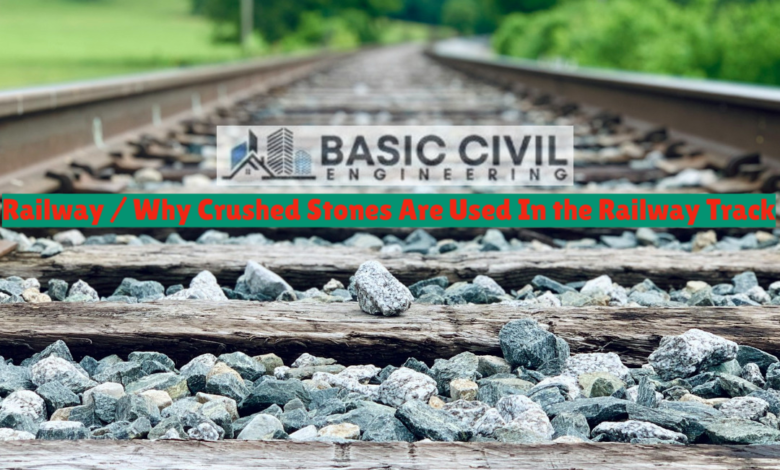
Why Crushed Stones Are Used In the Railway Track
These crushed stones are known professionally as “Ballast or track ballast.” Packing track ballast under railroad tracks with a tamping machine increases the tracks’ tensile strength. Along the railway, there is often a ballast layer (crushed stone 30/60 cm thick) that is 25–30 cm thick. This thickness fluctuates depending on several factors and circumstances.
The reasons for using crushed stone on railroad tracks are as follows:
1. Keep the rails in place and aid preserve gauge by holding the sleepers in place laterally and longitudinally.
2. To evenly transmit the weight of all moving cargo from the rails into the sub-base or formation (the ground area below the ballast).
3. To keep the cross ties supported and spaced apart.
4. To limit ground movements and heat expansion and contraction (caused by thermal strains).
5. To reduce vibrations because ballast gives the railway track an elastic quality by acting as a cushion.
6. To dampen vibrations – The air gaps between the stones dampen vibrations and provide comfort for both the passengers on the train and the nearby residents.
7. To promote drainage and prevent accumulation of rainwater from inclement weather (which can help to maintain adequate shear stress in the sub-base and ease frost heaves).
8. To combat plant and weed development from below.
9. To absorb the majority of noises and sounds made by train movements.
10. The track is flexible enough to accommodate any necessary minor modifications.

Surface railway, elevated railway, underground railway, and tube railway are all types of railway systems.
Systems Of Railway:
According to the local topography, trains can be installed above and below the ground’s surface. Additionally, the railways below the ground’s surface might be built at higher depths or just below it.
There are four different railroad systems:
1. Surface railways
2. Elevated railways
3. Underground railways
4. Tube railways.
Relateds Posts
-
Differents Types of Beams in Construction
-
Construction projects using concrete: Materials, Types, and Applications
-
16 Different Types Of Heavy Machinery Used In The Constructions
1. Surface Railway:
There are above-ground railways in this system. This is the best and most widely used railing in the entire world. The safe and effective crossing of the rail and road traffic requires the provision of a variety of the measures, such as level crossings, overbridges, underbridges, etc. on surface railways.
2. Elevated Railway:
The rails in this system are located higher up or on an elevated part above the ground. The track is carried on the steel deck of a continuous viaduct supported by piers, columns, etc. Because stations, waiting areas, and offices must be built at higher levels, needing stairways, escalators, etc., this system is exceedingly expensive. This kind of railroad is demonstrated in densely populated urban areas when underground railroads cannot be built.
3. Underground Railway:
This technique provides a railway that is slightly below the surface. The purpose of tunnel construction is to carry trains through them, and every road crossing requires an overbridge to cross over railroad traffic. Electricity is the only power source for traction on underground railways due to tunnel ventilation issues.
This technique is available in areas with high traffic densities and crowded roads.
Advantages:
a) This system offers quick, unhindered mobility.
b) By decreasing traffic congestion issues, this system.
c) In times of war, this system offers protection against aircraft attacks.
4 Tube Railway:
Tube railways are those that are offered underground at greater depths of 18 meters or more (up to 52 meters).
As a result of the track-carrying portion of the underground tunnels’ tube-like shape, this railway system has that name. The major goal of supplying tube railways is to prevent track interference with oil or drainage pipes, water and gas pipes, sewage systems, and other pipes.
The following list of key characteristics of tube railways includes:
1. The railroad stations must be cylindrical in shape.
2. To access the tube railways, escalators or moving staircases must be built.
3. Only electric traction should be used to prevent the smoke and ventilation issues.
4. Use of an automated signaling system is required.
5. The train should be equipped with a device that prevents it from starting until all the doors have been shut and that causes it to halt when the signal is in the stop position.
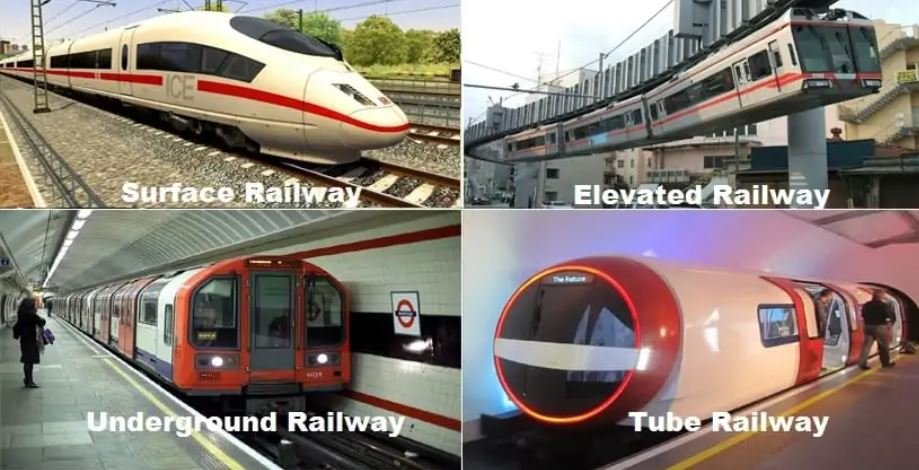
What Is the Railway Sleeper?
In order to maintain the proper spacing of gauge between two rail tracks, railway sleepers are a crucial railway component. Typically, these sleepers distribute the load to the ballast while resting on it. Railroad ties, railway ties, and crossties are other names for railway sleepers.
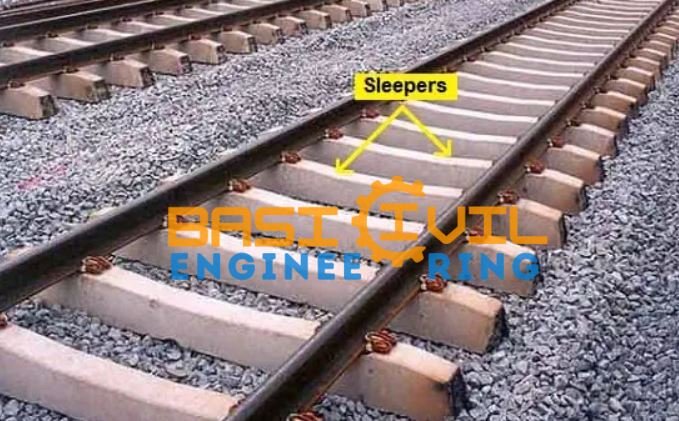
Railways use a variety of sleeper types according to their suitability, availability, economics, and design. The three categories of railroad sleepers are based on the materials used in their construction:
- Wooden sleepers.
- Metal sleepers.
- Concrete sleepers.
Types Of the Railway Sleepers
1. Wooden Sleepers
Timber sleepers are also referred to as wooden sleepers. Given that they met all the criteria for the ideal sleeper, these mattresses were commonly regarded as the best form of mattresses. But they are no longer widely utilized and have become outdated.
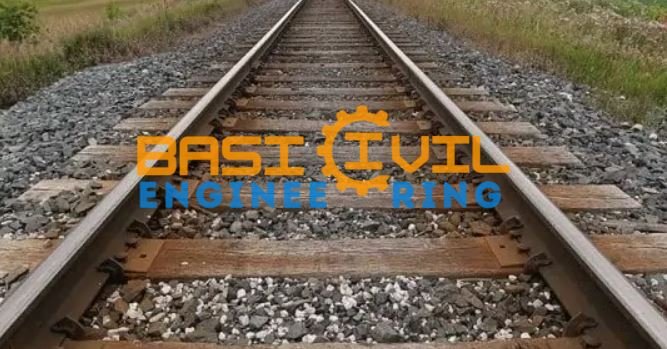
Advantages Of Wooden Sleepers
- There is no shortage of wood.
- The price of a hardwood sleeper is low at first.
- They only need a few easy-to-design fasteners, which are minimal in number.
- These sleepers are simple to move about.
- All sorts of ballast are suitable.
- They are suitable for usage with every rail section and on any gauge of track.
- Accidental injury is generally less severe.
- Circuiting on a track is best.
- Track renewal is simple.
Disadvantages Of Wooden Sleepers
- Compared to other types of the sleepers, the lifespan of hardwood sleepers is the shortest (12 to 15 years).
- They are susceptible to rot, white ant infestation, wear, killing spikes, cracking, splitting, rail cutting, etc.
- Due to the weaker connections between the rails and the sleepers, the track has reduced lateral and longitudinal rigidity.
- Difficulty keeping the track’s gauge.
- The high expense of upkeep.
- Low value as scrap.
2. Metal Sleepers
Metal sleepers are defined as typical cast iron or steel sleepers. Metal sleepers are currently employed extensively due to the dwindling availability of lumber for wooden sleepers and those materials’ high maintenance requirements, cast nature, and limited lifespan.
The two types of metal sleepers are:
a) Steel Sleepers:Steel sleepers are the name for the steel-made mattresses. There is a lot of use of steel sleepers, and it works wel
Types of steel sleepers:
- Key type steel sleepers
- Clip and bolt type steel sleepers.
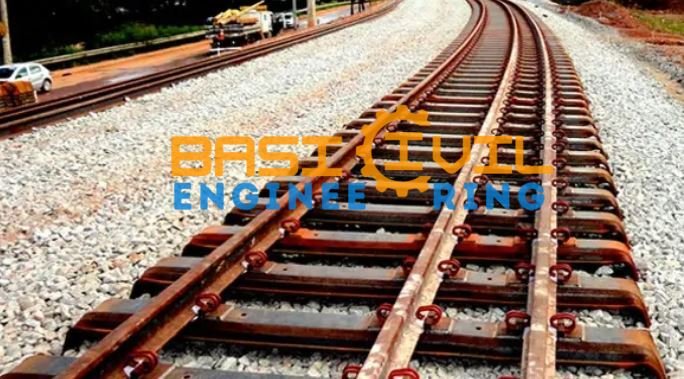
b) Cast Iron Sleepers: Cast iron sleepers are the name for the iron sleepers manufactured of cast iron. India uses these sleepers more frequently than any other nation in the globe.
Types of the cast iron sleepers:
- Pot or bowl sleeper.
- Plate sleeper.
- Box sleeper.
- CST-9 sleeper.
- Duplex sleeper.
Advantages Of Metal Sleepers
- Greater longevity (35 to 50 years).
- Uniform in terms of strength and toughness.
- Gauge maintenance and adjustment are simple.
- The track has greater lateral and longitudinal stability.
- Renewal only happens sometimes.
- High value as scrap.
Disadvantages Of Metal Sleepers
- They demand additional fittings.
- Rust can happen to metal.
- Extra ballast is necessary.
- These sleepers are not appropriate for level crossings, bridges, etc.
- The accident causes additional damage.
3. Concrete Sleepers
Concrete sleepers are defined as sleepers constructed from reinforced or prestressed cement concrete.
Concrete sleeper types include:
a) RCC sleepers:RCC sleepers are reinforced cement concrete railroad sleepers.
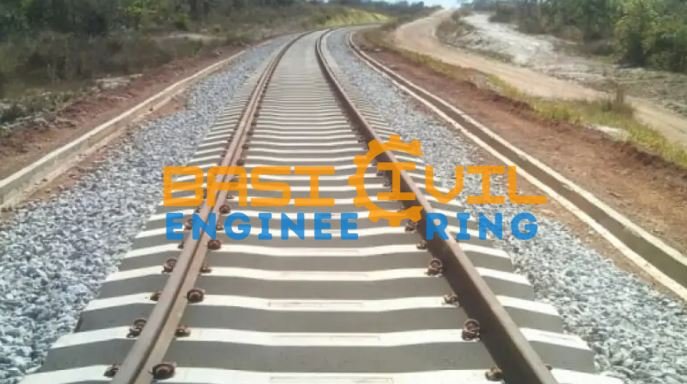
The two varieties of RCC sleepers are as follows:
- Mono-black sleeper,
- Two back sleeper.
b) Prestressed Concrete Sleepers:
Pre-tensioned concrete sleepers are another name for railroad sleepers composed of pre-tensioned cement concrete.
Advantages Of Concrete Sleepers
- (40 to 60 years) Long life expectancy.
- Fewer fittings are necessary.
- The gauge is simple and easy to adjust.
- They offer secure connections between the rail and the sleeper.
- The track has greater lateral and longitudinal stability.
- Circuiting a track is feasible.
- more resilient and less likely to degrade.
- Track creep has decreased.
- They can endure the strains brought on by busy, quick traffic.
- Low cost of maintenance.
Disadvantages Of the Concrete Sleepers
- The price is expensive at first.
- Prone to break when handled roughly or as a result of poor design.
- Renewal is challenging.
- The value of scrap is zero.




